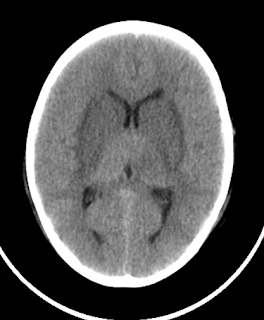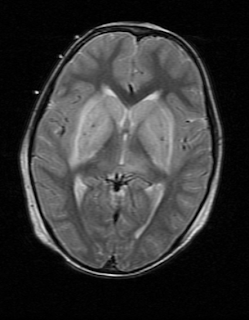Japanese Encephalitis





This is case of 5 yr old male who came to us with a history of high grade fever, headache, impaired consciousness and fever.
Initial brain CT revealed :
Bilateral basal ganglia hypodensities and asymmetric bilateral (L>R) thalamic hypodensity.
Patient was suggested MRI brain at our centre. The MR imaging demonstrated bilateral caudate nucleus hyperintensities on Axial T2WI, Fluid Attenuation Inversion Recovery Sequence (FLAIR). Aymmetric hyperintensities were also noted in bilateral thalamic region (L>R). Small hyperintense foci in posterior pons , midbrain and middle cerebellar peduncle were also seen on FLAIR sequences. Diffusion-weighted images showed diffusion restriction in bilateral gangliocapsular regions and thalamic region bilaterally (L>R).
Provisional Diagnosis – Japanese Encephalitis.
• Special predilection to affect subcortical gray matter such as thalamus, basal ganglia and substantia nigra.
• Less frequently cerebellum, pons, cerebral white matter and cortex are involved.
• Bilateral thalamic involvement – most frequent and characteristic finding.
• On MRI, hyperintense lesions on T2WI, FLAIR and hypointense on T1WI are classical.
• Haemorrhagic transformation not uncommon and presents as hyperintense lesions on T1.
• No or minimal enhancement on contrast study.
• Diffusion reveal more and early lesions
• Acute – cytotoxic edema – restricted diffusion
• Subacute – proportion of restricted diffusion decreases.
• Chronic – necrosis & demyelination – hypointensity on diffusion.
Initial brain CT revealed :
Bilateral basal ganglia hypodensities and asymmetric bilateral (L>R) thalamic hypodensity.
Patient was suggested MRI brain at our centre. The MR imaging demonstrated bilateral caudate nucleus hyperintensities on Axial T2WI, Fluid Attenuation Inversion Recovery Sequence (FLAIR). Aymmetric hyperintensities were also noted in bilateral thalamic region (L>R). Small hyperintense foci in posterior pons , midbrain and middle cerebellar peduncle were also seen on FLAIR sequences. Diffusion-weighted images showed diffusion restriction in bilateral gangliocapsular regions and thalamic region bilaterally (L>R).
Provisional Diagnosis – Japanese Encephalitis.
• Special predilection to affect subcortical gray matter such as thalamus, basal ganglia and substantia nigra.
• Less frequently cerebellum, pons, cerebral white matter and cortex are involved.
• Bilateral thalamic involvement – most frequent and characteristic finding.
• On MRI, hyperintense lesions on T2WI, FLAIR and hypointense on T1WI are classical.
• Haemorrhagic transformation not uncommon and presents as hyperintense lesions on T1.
• No or minimal enhancement on contrast study.
• Diffusion reveal more and early lesions
• Acute – cytotoxic edema – restricted diffusion
• Subacute – proportion of restricted diffusion decreases.
• Chronic – necrosis & demyelination – hypointensity on diffusion.
Japanese Encephalitis
 Reviewed by Sumer Sethi
on
Thursday, December 03, 2009
Rating:
Reviewed by Sumer Sethi
on
Thursday, December 03, 2009
Rating:
 Reviewed by Sumer Sethi
on
Thursday, December 03, 2009
Rating:
Reviewed by Sumer Sethi
on
Thursday, December 03, 2009
Rating:







1 comment:
Thanks for posting. This is of great interest to my daughter in particular, who is interested in becoming a radiologist.
Post a Comment